KOICA’s Advancement
Korea quickly overcame the economic crisis, and the size of KOICA’s budget increased 393% from 2000 to 2007. During this period, the total volume of bilateral ODA (Net Disbursement) increased 228% from 212 million USD to 696 million USD, and reached the ratio of 0.07% of ODA/GNI. This secured a foundation for KOICA’s expansion as a professional organization for international development cooperation.
1. KOICA’s Management Strategy
(1) External/Internal Management Environment
The issuance of the Millennium Development Goals (MDGs), including the goal to halve extreme poverty by 2015, symbolized the intensity of the international community’s focus on the development question. The international community was stating its demand for strengthened ODA partnerships for poverty reduction more strongly than ever before.
[Figure 1-1] UN Millennium Development Goals (MDGs)
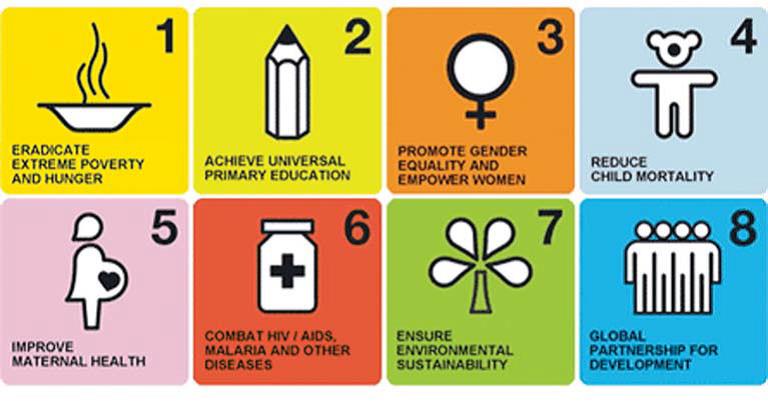
※Source: www.un.org.me
The opening of the 21st century saw progress towards the attainment of these goals in a very difficult environment. Efforts in pursuit of the MDGs spread hope for economic development, peace, and prosperity across the globe while the world was still reeling from the terrorist attack on the US World Trade Center on September 11, 2001, conflicts in Iraq and Afghanistan in 2003, and the earthquake and tsunami that devastated South Asia in 2004. Domestically, public awareness of Korea’s participation in such international efforts and public interest in ODA has risen. OECD/DAC membership required that Korea improve the quality and increase the quantity of its ODA contribution.
Against this backdrop, KOICA restored its budget to the level before the financial crisis in 1997 and set a goal of promoting poverty reduction, world peace, and democracy as universal values on a global scale. To reach this goal, KOICA encouraged quality development of international cooperation projects, focusing on human resource development in developing countries and strengthening KOICA’s public participation project system. With ten years of experience as an organization specializing in grant ODA, KOICA continues to use its know-how to develop and promote management innovation and capacity development.
(2) Management Strategy
KOICA’s management style has reflected that KOICA was established with the goal of “enhancing cooperative relationships and mutual exchanges with developing countries and supporting economic and social development in partner states.”In order to actively manage the external/internal environmental changes and to satisfy the purpose of KOICA’s establishment, KOICA held the ‘Workshop for KOICA Innovation Vision 2005’in December 2005 to discuss client and result based ODA administration. During this workshop, the image of KOICA as an ‘advanced aid agency working with the people was’ adopted and the staff reconfirmed their understanding of the organization’s purpose of promoting core capacity.
In November 2006, KOICA established the 『International Grant Aid Mid-Term Strategy (2007-2009)』 to provide an approach for handling increasing amounts of ODA. This prepared the basis for strategic grant ODA promotion by selecting four goals; ① poverty alleviation and supporting sustainable economic and social development in developing countries, ② enhancement of national interest by improving national image, ③ promotion of cooperative relationship with partner countries, and ④ cooperative advanced aid utilization with the people.
[Figure 1-2] KOICA Innovation Workshop
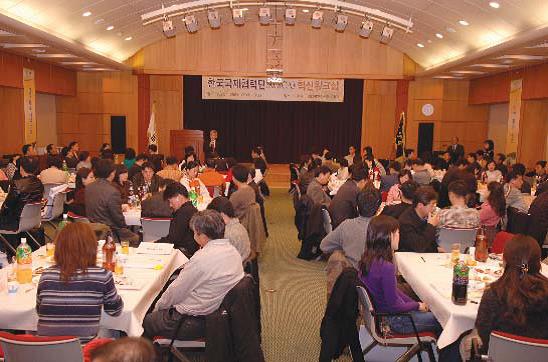
Source: Korea International Cooperation Agency. 2011. 20 years of KOICA 1991-2010, Translated by Institute for Development and Human Security, Ewha Womans University. Seoul.
2. Foundation for Organization Expansion and Specialization
The policy team of KOICA suggested a new management direction for handling the dynamic challenges of external and internal environmental changes. Through various dialogue channels, including board meetings and advisory committees, external and internal stakeholders have actively participated in ODA projects. This encourages the members of the local communities to take more ownership of their development. Additionally, KOICA staff gain important insight into the concerns of people in these developing countries. Recognizing the value of this open communication and cooperation allows us to appreciate the true value of KOICA.
(1) Board Meeting
KOICA has aimed to improve efficiency and enhance management transparency through strengthening the role of the board meeting. The board meeting determines KOICA’s important policy decisions by evaluating and voting on changes regarding its methods for project planning and management, budget and settlements of accounts, the opening and management of overseas offices and affiliated organizations, and the enactment or abolition of major articles. Board meeting attendees include the president, standing directors, and non standing directors. A total of 11 board meetings were convened between 2000 and 2007, resulting in 36 document resolutions. The productivity of these meetings has secured a sound foundation for responsible organization management.
(2) Advisory Committee
KOICA has assembled a committee to facilitate open communication regarding management direction and project planning. This committee is made up of experts from academia, journalism, and NGOs equipped with experience and knowledge in the international cooperation field. Meetings between KOICA and the advisory committee are held once or twice a year to share KOICA’s progress and the benefits of its ODA projects and to get feedback from the community leaders. Each consultant has played an important role in advancing public awareness of ODA.
(3) Domestic and Overseas Organization of KOICA
A. Domestic Organization
KOICA effectively responded to changes in the ODA environment by adopting a result-based management system. In 2000, the General Affairs Department was created and the Planning Department and the Policy Cooperation Office were combined into one Planning Management Department. The Planning Coordination Team was formed by merging the Planning Budget Team and the Regional Management Team with the purpose of facilitating coordination and communication between projects and departments.
In 2004, there was an urgent need for post-war reconstruction in Iraq and Afghanistan. KOICA expanded its Afghanistan Support Team to establish the Afghanistan Support Headquarters. In 2005, the team was again upgraded to an independent support system for the reconstruction efforts and renamed the Afghanistan Reconstruction Support Headquarters. Also in 2005, the Regional Policy Team was established to strengthen policy implementation and in 2006, the Team was expanded to become the Regional Policy Department. This department’s purpose is to improve coordination between various regional departments, and to advance result management. The Project Policy Team, an exclusive taskforce to lead the structural reorganization of the agency, was set up to assign tasks regarding health, education, governance, ICT, environment and gender into sectoral teams.
Hence, in the second half of 2006, KOICA disbanded its project-based organization units such as the Project 1 Team, Project 2 Team, and the Development Studies Team. By reorganizing its workforce into theme based sectoral teams, KOICA encouraged staff to focus more narrowly on their areas of expertise in each theme and thus managed to save substantial funds. The Project Evaluation Office split off from the Planning Department and was put directly under the Office of Board of Directors for the effect of enhancing its independence and strengthening coordination with policy research.
In 2000, in order to improve human resource management efficiency, many positions were eliminated or merged. This, in combination with the rapid expansion of grant ODA projects, increased the overall workload of each staff member. KOICA increased its total number of staff from 203 to 220 to lesson this burden and further ensure efficient project implementation.
B. Overseas Organization
In response to the increased workload, changes in program environment, and changes in the policies of partner countries, a number of new overseas offices were opened while some existing overseas offices were closed or replaced in 2000. The Afghanistan overseas office was established in 2002 to support post-war restoration projects and then in 2003, seven overseas offices were established to follow the international trend of taking a field-oriented approach to increasingly large ODA projects. To strengthen overseas program capacity and solidify the foundation for field-oriented program implementation, additional staff members were dispatched to six of the overseas offices in 2006.
3) Institutional Reform for Effective Development Cooperation
(1) KOICA’s Selection and Focus’ Implementation Strategy and Organization Reshuffling
In 2005, the Planning Coordination Team was divided into the Regional Policy Team and the Planning Budget Team. One of the Regional Policy Team’s first acts was to establish a three-year mid-term Country Program (CP) to align KOICA’s ODA strategies with the Poverty Reduction Strategic Papers (PRSP) and the MDGs. This program also coordinated KOICA’s development projects and partner countries’ economic development goals more thoroughly. With the establishment of the ‘2005-2009 International Grant Aid Program Strategy in December 2005, partner country selections were made by the principle of ‘selection and focus. This laid the foundation for region-based specialization.
The Policy Project Team hosted a grant ODA project assessment workshop on July 1, 2006 and based on this workshop, the former project-based organization was reshuffled into seven priority support sectors; health, education, governance, ICT, rural development, industry and energy, environment and gender. This allowed new sectoral teams to develop specialization as they narrowed their focus. It also harmonized cooperation and the division of responsibilities between teams. The Regional Policy Team was expanded into the Regional Policy Department which consisted of the Policy Planning Team, Regional 1 Team, and Regional 2 Team. The department was restructured in this way to encourage cooperative policy establishment based on the partner countries’ needs and to promote policy dialogue with the governments of these countries. KOICA continued its organizational restructuring and promoted the Project Evaluation Team to the Project Evaluation Office in an attempt to strengthen project assessment functions. Accordingly, project guidelines and autonomous decision making procedures were modified. Additionally, the director of the Disaster Restoration Support Department was promoted to a standing board member in order to respond to increasing external demands for foreign disaster relief and reconstruction and the demand for increased organizational capacity building.
(2) Amendments to KOICA’s Project Implementation Guidelines and the KOICA Act
In 2006 and 2007, KOICA revised its project implementation guidelines to create a more autonomous and flexible project implementation system. The creation of the new system was overseen by the Minister who, according to the KOICA act and the enforcement ordinance, has the authority to determine which specific matters will be included when amending these guidelines.
The guideline revisions also highlighted government policies related to ODA and diplomatic decisions and clearly defined the division of duties between the Ministry of Foreign Affairs and KOICA, thereby improving work efficiency. To better facilitate KOICA’s projects in partner countries, KOICA affiliated its overseas offices under the Korean embassies and the dispatched KOICA staff received diplomatic passports to clarify their status. KOICA also began inviting civilian figures to participate in a committee to strengthen the base for effective work and to advance transparency and objectivity in ODA projects.
In 2007, the Global Poverty Reduction Contribution Fund-also called the Air-ticket Solidarity Contribution-was established to further the global effort to eradicate poverty and disease, with a special focus on Africa. This innovational fundraising strategy collected 1,000 KRW for every international air ticket sold in Korea into a fund managed by KOICA. The KOICA Act was revised to include a detailed description of how this fund would be managed and employed.
[Figure 2-1] Goals of the Global Poverty Reduction Contribution Fund

- Support the eradication of three critical deseases in LDCs through UNITAID
- Support the eradication of deseases in Africa through the private sector
- Support the eradication of deseases requested by African LDC governments
Source: Korea International Cooperation Agency. 2011. 20 years of KOICA 1991-2010, Translated by Institute for Development and Human Security, Ewha Womans University. Seoul.
3. KOICA’s Reinforcement of Development Cooperation Specialization
From 2008 to 2010, the management environment in which KOICA was operating changed substantially. During this time the government was trying to meet increasing external demands for larger ODA contributions to partner countries and was working towards OECD/DAC membership.
The government prepared the ‘Comprehensive Measures for International Development Cooperation Improvement’ in November 2005, and established the International Development Cooperation Committee in March 2006. The committee was created to expedite Korea’s admission to the OECD/DAC and was supervised by the Prime Minister’s Office.
Starting in 2005, Korea became more concerned with its ODA contribution as it was both directly and indirectly related to the main affairs of the state. From the onset of the Lee Myung-bak administration in 2008, the government adopted state missions to highlight the importance of ODA. In these missions, Korea declared its intent to ‘contribute to solve global issues,’ ‘expand diplomacy through aid contribution,’ ‘expand cooperative diplomacy in Asia,’ ‘foster young global leaders,’ and to ‘combat climate change through more sustainable energy policies.’ In order to achieve these goals, Korea undertook efforts to improve its ODA. In 2009, Korea achieved one of its goals and became a member of the DAC. In 2010, Korea passed the Framework Act on International Development Cooperation and pledged to increase the volume of its ODA to 0.25% of the GNI by 2015. The government also stated its official basic philosophy for ODA. These changes allowed KOICA to make exemplary progress in ODA management and create an advanced system for ODA distribution far ahead of other related organizations. KOICA’s remarkable success has earned it international recognition as a think-tank for providing policy recommendations regarding grant aid management.
1) Joining the OECD/DAC and the future Task of Korean ODA
(1) Becoming an OECD/DAC Member
In the mid-2000s, Korea’s ODA projects were receiving international attention and Korea was recognized as promising new ODA donor. In 2006, the Prime Minister’s Office drew up a roadmap for joining the OECD/DAC. This roadmap incorporated the ‘Foreign Assistance Policy Improvement Plan, ’drafted on December 30, 2004 drafted by the Presidential Advisory Sustainable Development Committee, and the ‘Foreign Aid Improvement Comprehensive Measures, ’prepared in a cabinet meeting on November 15, 2005.
In June 2007, a working group to organize Korea’s efforts towards joining the DAC created. This working group was composed of personnel from the Prime Minister’s Office, the Ministry of Foreign Affairs, the Ministry of Finance and Economy, the Ministry of Planning and Budget, KOICA, and the Korea Exim Bank. The DAC Special Review Team visited Korea for a preliminary assessment in March 2008 and in August 2008. The 4th International Development Cooperation Committee proceeded with plans for Korea to become an OECD/DAC member in 2010 and submitted Korea’s membership application in January 2009. Six months later, inspectors from DAC visited Korea. Their assessment report was submitted in September and Korea officially became the 24th DAC member country on November 25, 2009.
(2) Joining OECD/DAC and Task for ODA System Improvement
While Korea was working towards becoming a DAC member, it was evaluated by the DAC Special Review Team. The evaluation from this team recommended several ways that Korea could raise its ODA to the standard of other DAC member countries. The most pressing assignments included the reorganization of ODA legal framework, increasing the volume of ODA, improving efficiency in ODA resource allocation, improving capacity to effectively manage ODA projects, participating in the international community’s effort to enhance ‘development effectiveness,’ and furthering improvements in the humanitarian aid system. After restructuring, KOCIA could coordinate ODA projects more efficiently.
[Figure 3-1] Joining the OECD/DAC (November 25, 2009)
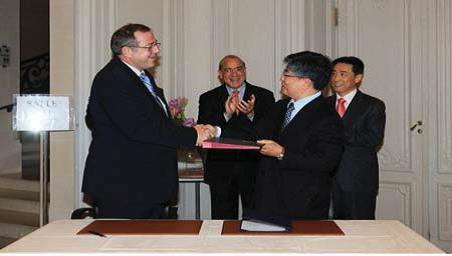
■ Kim Jung-soo, Korean Ambassador to the OECD, receives the OECD/DAC membership acceptance letter from Angel Gurria, Secretary-General of the OECD.
Source: Korea International Cooperation Agency. 2011. 20 years of KOICA 1991-2010, Translated by Institute for Development and Human Security, Ewha Womans University. Seoul.
2) The Korean ODA System Advancement and Improvement of KOICA’s Specialization
(1) The Government’s ODA System Advancement and KOICA’s Contribution
A. Enactment of the Framework Act on International Development Cooperation and KOICA’s Project Orientation
ODA policy fragmentation has consistently been a stumbling block for development project effectiveness. To combat this, OECD/DAC member countries have each enacted ODA Basic Laws or established mid-term policies to promote policy effectiveness and coherence. Through such efforts, they have created consistent ODA action guidelines for ODA stakeholders.
The Korean government has shown its commitment clearly to improving its ODA policy. In Korea, the 17th National Assembly (2004-20008) officially discussed the creation of a basic act to promote ODA policy consistency and development effectiveness. This received the most attention in 2008 when ‘OECD/DAC Special Review’ recommended that the Korean government promote policy coherence and effectiveness through the passing of a basic act and policy modification.
The Framework Act on International Development Cooperation (hereafter “Framework Act”) passed the general assembly of the 18th National Assembly on December 18, 2009, and the Framework Act and Framework Act Enforcement Ordinance came into effect on July 24, 2010. This law was designed to achieve policy coherence and development effectiveness.
[Box 3-2] Main Contents of the Framework Act on International Development Cooperation
| 1. Definition of ODA A. Bilateral ODA consists of grants and loans B. Multilateral ODA is defined as contributions and subscription to international organizations and concessional loans 2. ODA’s mission and goal A. Poverty Reduction in Developing Countries B. Mother and Child Rights Improvement and Gender Equality C. Sustainable Development and Realization of Humanitarianism D. Enhancement of Economic Cooperative Relations with Partner Country E. Peace and Prosperity in the International Community 3. Relationship with other Laws - The government must respect the goal and philosophy of the Framework Act when enacting or revising a related law. 4. Strengthening the function of International Development Cooperation Committee -The Committee deliberates and coordinates main issues in order to comprehensively and systematically promotes ODA policies and evaluations. 5. To suggest ODA policy orientation through drafting and revising ODA basic plans every five years 6. Division of responsibilities - MOFAT controls grant aid and MOSF controls loans. 7. Enhance cooperation efficiency by selecting core partner countries 8. Improvement of transparency through an integrated ODA evaluation system 9. Promotion of public participation - Korea’s major accomplishments and evaluations regarding ODA performance should be disseminated to the public. 10. Foster professional workers strengthen international relations, submit ODA statistics 11. Clarification of the role of embassies during the ODA implementation process |
KOICA has strengthened its expertise in line with the basic spirit advocated in the Framework Act. First, KOICA established gender mainstreaming strategies to improve women’s rights and gender equality. In 2009, KOICA set up a training program for foreign civil servants and stipulated that 30% of the trainees should be women. Furthermore, this program included new specialized courses such as ‘Gender and Development.’ In addition, ‘Rules for Gender Equality Enhancement and Women’s Capacity Building’ ere enacted to institutionally support gender mainstreaming. Since June 2009, KOICA has been attending‘ GENDERNET,’ one of the DAC’s policy networks, and has been making policy recommendations as well as modifying KOICA’s policies to meet DAC aid norms.
Second, KOICA has expanded its mother and child health projects. These projects are now taking place in Peru, Ethiopia, Bolivia, the Philippines, and Cambodia to enhance children’s rights and reduce of mortality rates of children under the age of five. In Guatemala, KOICA has contributed to the enhancement of child rights by supporting alternative education for refugees and street children who do not go to school.
Third, KOICA has improved its international disaster relief, post-war restoration, and peace-building efforts. This was achieved by strengthening the humanitarian aid functions of KOICA’s Disaster Restoration III Team, managed by the Disaster Restoration Aid Headquarters since 2005, and the reorganization of the Humanitarian Aid Team and Humanitarian Aid Office.
Fourth, KOICA has been functioning as a think-tank to uphold the goals outlined in the Framework Act. KOICA conducts research on ODA trends and OECD/DAC norms, establishes both broad regional/country strategies and strategies in specific sectors such as education or health, and shares its research results, project lessons, and evaluation results. These shared findings have been reflected in government policy, which in turn improves KOICA’s project implementation. The information is also shared with the general public to raise awareness of Korea’s ODA programs and is included in textbooks published by the International Development Education Academy.
Fifth, KOICA has strengthened the functions of its 44 overseas offices to realize the goals stated in the Framework Act. These offices now increase the positive outcomes of ODA programs through close cooperation with partner countries. KOICA is the only organization in Korea utilizing field-based strategies in ODA implementation.
B. The Function of International Development Cooperation Committee and KOICA’s Strategy
On January 26, 2006, the International Development Cooperation Committee was established under the Prime Minister’s Office to evaluate the main policy and basic plans regarding ODA. This evaluation was conducted for the purpose of ensuring sustainable development in developing countries and mutual prosperity for Korea and its partner countries. The Committee is chaired by the Prime Minister, and the Assistant Administrator holds the office of Head of the Prime Minister’s Office. The Committee consists of 20 members including the Ministers from 11 Ministries including the MOFAT and the MOSF, the President of KOICA, the President of Korea Exim Bank, and six civilians. By the end of 2009, the Development Cooperation Policy Office was newly established under the Prime Minister’s Office to administer the Committee, strengthen coordination, and to act as a secretariat.
The Committee has made important decisions and coordinated central policies. A few of its major achievements include aiding Korea’s admission to the DAC, establishing Korea’s ODA mid-term strategy, creating roadmaps for untied aid, establishing ODA advancement measures, hosting the Busan HLF-4, and unifying grant and loan projects in core partner countries. A total of eight committee meetings were held by the end of 2010 and decisions made during these meetings have been actively reflected in the organization’s management strategy and ODA projects.
[Box 3-3] International Development Cooperation Committee Meetings
■ The First Committee (03/02/2006)
|
■The Fifth Committee (05/01/2009)
|
Source: Korea International Cooperation Agency. 2011. 20 years of KOICA 1991-2010, Translated by Institute for Development and Human Security, Ewha Womans University. Seoul.
A. Expansion of the Volume of ODA
In 2000, the international community agreed to target ODA towards achieving the MDGs. In this spirit, the International Conference on Financing for Development in Monterrey was hosted in 2002 to secure financial resources for this effort. The conference participants committed to increase their volume of ODA to 0.7% of their respective GNI. Accordingly, each donor has been trying to expand their national ODA budget, and has adopted plans for debt relief and innovational financing for development.
[Table 3-4] Korea’s Expansion Plan for ODA expressed in relation to the GNI (2007~2015)
(Unit: %)
| 2007 | 2008 | 2009 | 2010 | 2011 Target | 2012 Target | 2013 Target | |
| Korea | 0.07 | 0.09 | 0.10 | 0.13 | 0.14 | 0.15 | 0.25 |
| OECD/DAC Average |
0.27 | 0.3 | 0.31 | 0.32 | - | - | - |
However, the volume of Korea’s ODA in 2007 was 700 million USD, which accounted for only 0.07% of its GNI. This figure fell far short of the international average rate of 0.28% for OECD/DAC members in 2007, and was disappointingly small compared to the size of Korea’s economy. This was undeniable evidence that Korea needed to increase its volume of ODA. The 4th International Development Cooperation Committee met in August 2008 and made plans to increase the ratio of ODA/GNI to 0.15% by 2012 and to 0.25% by 2015. KOICA’s budget has increased from 193 million USD in 2006 to 270 million in 2007 USD, reaching 275 million USD in 2008, and 276 million USD in 2009. The budget was maintained at around 270 million USD between 2007 and 2009, but substantially increased to 454 million USD in 2010. KOICA has been making great efforts to efficiently execute the expanded budget by increasing human resources, rationalizing project processes, and improving ODA resource distribution.
B. Enhancing the Efficiency of ODA Resource Distribution
■ Using the‘ Selection and Focus’Principle to Choose Cooperation Partner Countries
As the volume of Korean ODA has increased, the government has responded by modifying its aid allocation system by implementing the principle of‘ selection and focus.’Aid is now allocated by country and sector using this new principle. Thinly spread resources, funding Korean ODA efforts in more than 50 countries, had previously caused major problems for the government. Therefore, the 7th International Development Cooperation Committee met in October 2010 and decided to cut the pool of core partner countries to 26 and to integrate grant and loan ODA. The Committee also established an integrated Country Partnership Strategy (CPS) to coordinate projects happening in all 26 countries with relevant organizations. KOICA has been the sole ODA institution in Korea that leads the ‘selection and focus’strategy particularly by fostering regional experts.
■ Selection and Focus’on Sectors
KOICA is changing its project selection paradigm to a sectoral, program-based system in order to resolve problems caused by sporadic assistance mainly based on the partner country’s demand. Considering cross-cutting issues such as gender and environmental preservation, the sectoral programs included in the CPS are implemented by selecting programs in which Korea has comparative advantages. The CPS will also provide customized support to each partner country through policy dialogues with the local governments. KOICA created ‘KOICA Advancement Plans 2010-2015: A Roadmap for Progressing as a Global ODA Specialized Organization’(2010). This plan was designed to allow Korea to use its comparative advantage in certain fields to make its projects more effective. Accordingly, the agency reduced its core sectors from seven to five, selected 25 specific programs, and utilized results from previous projects to set up implementation models for each new program and the CPS.
[Figure 3-5] KOICA’s Reform in Core Supporting Sectors
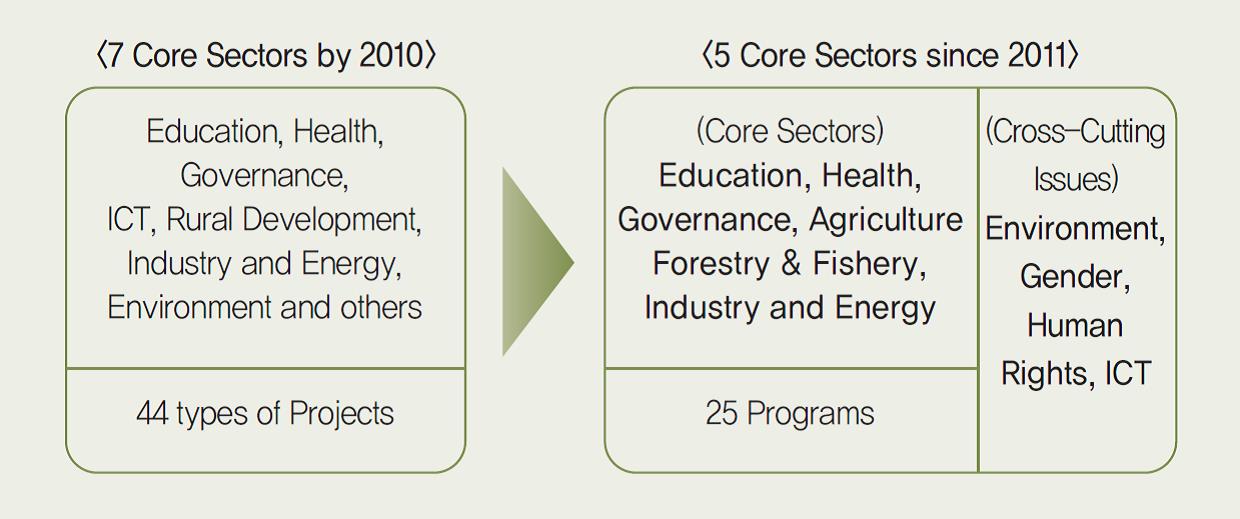
KOICA tries to promote the Program-Based Approach (PBA). This approach aims to strengthen development capacity in the partner country by taking their respective national developmental and sectoral needs into consideration. By using the PBA, KOICA hopes to make its project implementation system more similar to those used by traditional DAC members by 2015.
(3) Participating in Global Efforts to Enhance Aid Effectiveness
The ‘Paris Declaration on Aid Effectiveness (Paris Declaration)’, adopted in February 2005 at the OECD/DAC‘ High Level Forum on Aid Effectiveness,’is the seminal document on ‘aid effectiveness.’The declaration draft drew lessons and principles from the ‘Rome Declaration on Aid Harmonization’(2003), and the ‘Joint Marrakech Memorandum’(2004) which deals with development result management. The five main principles suggested in the Paris Declaration are ownership, alignment, harmonization, managing for results, and mutual accountability.
Korea made efforts to increase its aid effectiveness even before joining the OECD/DAC. It participated in the implementation survey of the Paris Declaration and becoming one of the declaration’s signatories. Through all of its ODA reforms, Korea has paid close attention to compliance with international aid norms and plans of execution based on the Paris Declaration. In 2011, as the host country of the HLF-4, Korea is in a position to present the evaluation of each country’s progress in achieving the goals of the Paris Declaration. KOICA’s efforts to improve its aid effectiveness include expanding untied ODA, strengthening ODA predictability, and strengthening aid coordination between donors.
[Figure 3-6] International Meetings on Aid Effectiveness
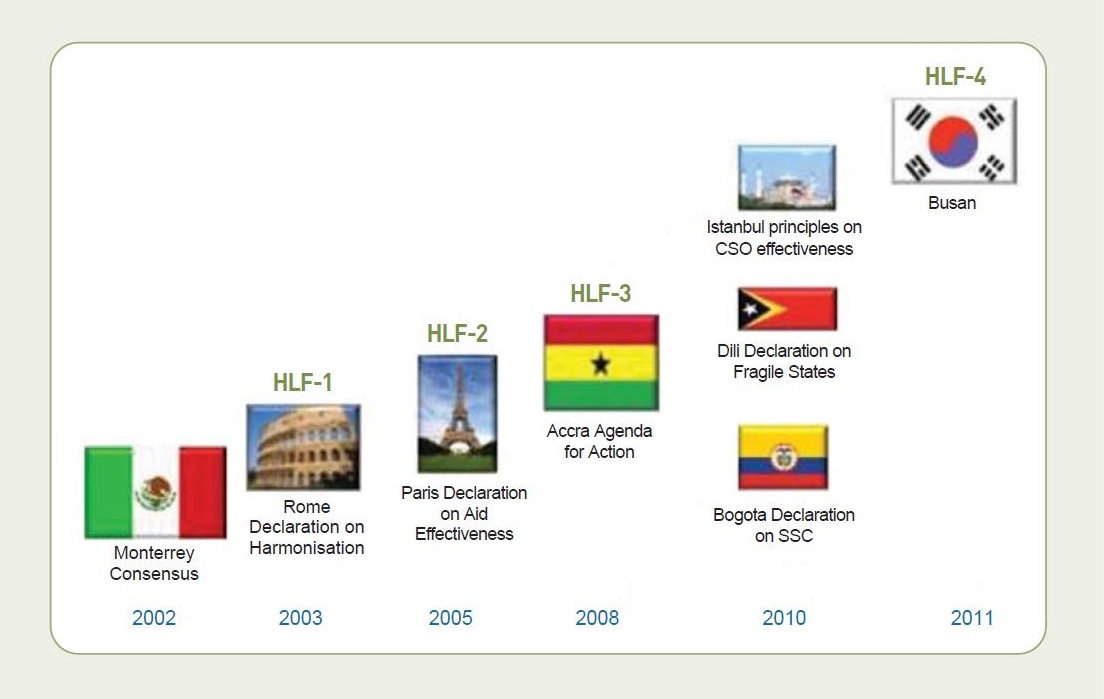
A. Expansion of Untied ODA
In April 2001, following a recommendation from the OECD/DAC High
Level Meeting on Expanding Untied ODA to LDCs, a consensus was reached to open opportunities for companies working with KOICA to international firms. This would contribute to enhancing the cost effectiveness, transparency, and accountability in ODA projects. The Korean government hosted the second International Development Cooperation Committee in January 2008 for the purpose of expanding untied ODA. Untied ODA accounted for a mere 2.6% in 2005. The Committee decided to launch a roadmap for expanding untied aid by 2015 and drew up plans to expand untied ODA grants by 100% and loans by 50%.
In April 2007, KOICA revised its regulations on the procurement of funds in preparation for making 100% of its ODA untied aid. Then in 2008, KOICA launched the‘ Promotion and Expansion Plans for Untied Aid.’Thanks to these initiatives, the ratio of untied aid rose to 39% in 2009 and 50% in 2010. In 2010 KOICA put new emphasis on spreading information about its ODA projects to businesses. KOICA provided Korean companies with information about bids on ODA program jobs to encourage their participation and KOICA and the Korea Trade-Investment Promotion Agency (KOTRA) jointly hosted an information session on the expansion of untied aid. KOICA been endeavoring to improve its own procurement system and enhance the capacity of partner countries through pilot programs utilizing the procurement systems of the partner countries. These pilot programs include vocational training programs in Mongolia and Vietnam in 2010, capacity building training for foreign procurement officers in Korea, expansion of projects for financial management and procurement capacity building, and building e-procurement systems.
B. Strengthening Aid Predictability
In order to strengthen the efficiency and predictability of aid allocation, KOICA and MOFAT established the‘ Grant Aid Medium and Long-term Strategy: 2008-2010’in 2008. In October 2010, the 8th International Development Cooperation Committee introduced the ‘Grant Aid Basic Plans: 2011-2015’to combat these challenges. This set of plans stipulated how grant and loan aid should be integrated for the 26 core partner countries and approved reconstruction assistance to three countries including Iraq and Afghanistan. To enhance aid predictability, plans have been made for establishing an integrated grant and loan CPS for all 26 core partner countries by 2012, and by sharing it with each partner country. KOICA has made policy recommendations based on its research to establish the CPS system and reformed the organization into region and field-based units.
C. Strengthening Aid Harmonization among Donors
KOICA is dedicated to increasing aid harmonization with its partner countries. It strongly encourages overseas offices to participate in coordination meetings among aid donors and to attend aid conferences held in their respective countries. KOICA has been preparing a program selection framework that allows aid harmonization with other ODA organizations within the CPS. In February 2010, KOICA Headquarters established joint cooperation basic plans with other ODA donors including the US, Japan, Canada, U.K. and Australia.
Source: Korea International Cooperation Agency. 2011. 20 years of KOICA 1991-2010, Translated by Institute for Development and Human Security, Ewha Womans University. Seoul.
